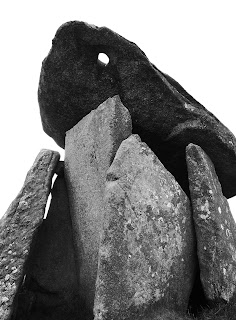How I miss the bright, sunny days of late summer! Fortunately I can easily conjure them back by looking through my vast photo collection. I enjoyed many carefree holiday moments this year, and to be honest wasn't much thwarted during the four months or so between the two big lockdowns in England.
On 13th September I spent a day in the far west of Cornwall, heading first for Penzance, then St Just, then the lighthouse at Pendeen Watch, and finally Lanyon Quoit, the famous dolmen. I'd been here before, in early November 2010, when I secured these late-afternoon shots:
Lanyon Quoit has become one of the iconic sights of Cornwall. But what you see now isn't how it was originally. It was once a burial chamber completely hidden inside an earthen barrow. The earth part vanished long ago, leaving four upright stones standing, capped by a large twelve-ton slab. I should think it must have resembled Trethevy Quoit on the south-east edge of Bodmin Moor, which looked like this when I shot it in July 2010:
Eventually Lanyon Quoit must have become unstable, and it fell during a wild storm in 1815, damaging one of the uprights very badly. In 1824 it was re-erected after money had been raised from a local subscription. But only three of the original uprights were serviceable - so it now had to stand lower to the ground, with the big slab uncompromisingly horizontal.
I suppose the naval team, who undertook the work with their block-and-tackle, did their best. They had to ensure that the remaining usable stones were firmly planted in good ground, and that the result was visually striking. In that they succeeded: the dolmen is still standing to this day, and it is indeed a striking sight. But it's at right angles to its former position, besides being radically different from its pre-1815 appearance. It's not the real thing any more, and it must seem a horrible travesty to archaeologists!
Really, it was high time that something was done to restore the dolmen to its former authentic glory. So when I came along on 13th September, I studied the stones with the eye of a trained engineer. (Which doesn't of course mean that I was in fact a trained engineer. But I assert that I was in spirit.)
Yes...that capstone just needed a bit of a shove. A bit of shoulder in the right spot. And then heave it sideways a little. As you can see, I was full of confidence.
I got into position. I took the weight.
Then I gave it an upward heave. But it needed more oomph than I thought.
Would you believe it, it wouldn't budge! Not an inch. Astonishing!
After several minutes' effort, all to no avail, I decided to give up. I know when I'm beaten. I reckon that nineteenth-century naval team must have inserted steel pins to hold the slab onto the uprights. Huh, what a rotten thing to do.
Well, I had to get back to Carnon Downs for a cup of tea, my afternoon snack, and a kip. I couldn't stay here too long. Reluctantly, I walked away. As I reached Fiona, another car stopped in the lay-by and a couple got out. I gave them a socially-distanced hello. I wondered whether I should stick around, to see whether their two shoulders working together would succeed where on my own single shoulder had failed. They were bound to have a go. And after nearly two hundred years those steel pins could well have been quite rusty, so that a combined heave at the right moment just might have done the trick. You never know.













